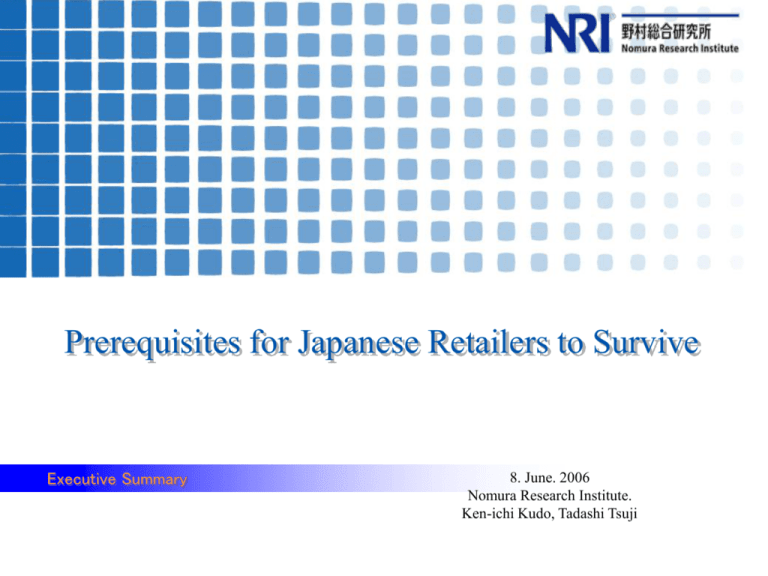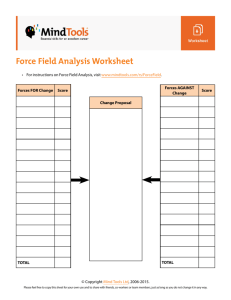
Prerequisites for Japanese Retailers to Survive
Executive Summary
8. June. 2006
Nomura Research Institute.
Ken-ichi Kudo, Tadashi Tsuji
Conclusion: Task for Japanese retailers to survive
Japanese population started to decrease in 2005: Therefore age composition and household
composition will be fragmented.
In such situations, Japanese retailers need to make strategies to survive.
Japan’s strategies to survive are different from United States’, where population will increase for a
while. Japanese retailers need to find their own strategies other than to copy United States’.
It is necessary to understand consumers’ behavioral change at all time and to continue to find
out who will be customers and when and where they purchase.
Consumer behavior is always changing. Japanese retailers need to catch the changes agilely,
and to sustain flexibly appeals and freshness of their store layouts, assortments and prices as
contact points with customers, in each hierarchy of format, region, store and department.
Japanese retailers need to design and operate such internal functions that don’t lose efficiency
even if contact points with customers flexibly change.
Copyright©2006 Nomura Research Institute, Ltd. All rights reserved.
1
Content
Fact Analysis
1. Back ground and Objectives
Proposal
2. Consumption structure in Japan
to 2020.
5. Prerequisites for Japanese retailers to
survive in 2010
3. Retail formats with consumers
behavior in present-day Japan
4. Trend of major retail formats
6. Conclusion
Proposal
to the future
Fact up to date
NRI’s view point
Copyright©2006 Nomura Research Institute, Ltd. All rights reserved.
2
1. Back ground and objectives
1) Aging society with a falling birthrate
Japanese population started to decrease in 2005, since then aging society with a
falling birthrate has started seriously.
百万人
Population decrease and saturation of retail market will become selection pressure
for innovation to survive.
Japanese Population
130
128
126
124
122
120
118
116
114
112
110
30年
25年
20年
15年
10年
05年
00年
95年
90年
85年
80年
出所: 国立社会保障・人口問題研究所
Copyright©2006 Nomura Research Institute, Ltd. All rights reserved.
3
1. Back ground and objectives
2) Objectives
Quantitative data of consumer market in
Japanese aging society with a falling
birthrate to 2020.
Analysis for prerequisites to survive in
such situations.
Copyright©2006 Nomura Research Institute, Ltd. All rights reserved.
4
2. Consumption structure in Japan to 2020.
In a period of population decrease, the amount of real consumption expenditure will
stop growing. Information strategy to compete for fragmental potentials of
consumers attribution, item, and area will become a matter of business survival.
‘”particular” consumer’, ‘smart consumer’, ‘safety-oriented consumer’ will arm
with information and express their will by selecting items and formats. Companies
which ensure information disclosure and obtain loyalty from consumers will survive.
1) Fragmental consumption potential
2) Consumers arming with information
Area
Increase of “particular”consumers
Item
Increase of smart consumers
Increase of safety-oriented consumers
Consumers attribution
Copyright©2006 Nomura Research Institute, Ltd. All rights reserved.
5
2. Consumption structure in Japan to 2020.
1) Fragmental consumption potential
Japan will not have a real consumption growth.
Although Japanese population will decrease, the number of household will not decrease.
Aging people whose real consumption per household is large will increase, but the growth
of real consumption expenditure is estimated to stop as a whole.
Forecast of real consumption expenditure in Japan
(兆円)
350
→推計値
300
250
エクセル:「都道府県支出年齢階層別」に掲載
200
150
100
出所
実績値:SNA 内閣府
推計値:人口問題研究所世帯数の推移
をもとにNRI推計
推計値
50
実績値
0
85年
90年
95年
00年
05年
Copyright©2006 Nomura Research Institute, Ltd. All rights reserved.
10年
15年
20年
6
Area
2. Consumption structure in Japan to 2020.
Item
1) Fragmental consumption potential
Consumers attribution
Widen the gap each age segment, the consumers attribution will be fragmented.
Possible to overlook a growth target in case sticking to their past target.
The amount of consumption expenditure in 50s (baby boomer) decreases by 2.5 trillion yen.
In 70s, it increases 1.6 trillion yen.
Increase and Decrease of house hold from 2005 to 2010
( more than one member of family)
2,000
1,500 (10億円)
1,000
500
0
-500
-1,000
-1,500
Copyright©2006 Nomura Research Institute, Ltd. All rights reserved.
75歳以上
70~74歳
65~69歳
60~64歳
55~59歳
50~54歳
45~49歳
40~44歳
35~39歳
30~34歳
25~29歳
25歳未満
-2,000
(出所)NRI
7
Area
2. Consumption structure in Japan to 2020.
Item
1) Fragmental consumption potential
Items will be fragmented with increase of single household and
Consumers attribution
aging household.
‘food’ and ’housing’ will increase slightly and ‘clothing’ will decrease slightly.
(兆円/年)
1.5
1
0.5
商品分類別支出の増減額
衣
食
住
104
102
100
98
0
96
-0.5
2005年
2010年
2020年
Segment
Clothing 1% ↓
Food 2% ↑
Housing 3% ↑
商品分類別支出の変化率
(%)
衣
2005年
食
2010年
住
2020年
Main Factor
General household, which has huge expenditure for clothing will decrease. Male single
household and aging household will increase.
Male single household, which has huge expenditure for food, will much increase than
population decrease.
Aging household, which has huge expenditure for housing, will increase.
Copyright©2006 Nomura Research Institute, Ltd. All rights reserved.
(出所)NRI
8
2. Consumption structure in Japan to 2020.
1) Fragmental consumption potential
Differentials in rapidity of population decrease and
age composition by region will be wider,
and area distribution will be fragmented.
Widened differentials between
increase (red) and decrease (blue) more than 5%
Changing rate of consumption expenditure
(2005 to 2020)
:1.05~
:1.00~1.05
Area
:0.95~1.00
Item
:~0.95
(出所)NRI
Copyright©2006 Nomura Research Institute, Ltd. All rights reserved.
Consumers attribution
9
Area
2. Consumption structure in Japan to 2020.
1) Fragmental consumption potential
Item
Urban edge in Kansai (around Osaka)
Consumers attribution
will become a growth area in 2020.
Otaru (7)
Muroran (1)
Hakodate (2)
Kushiro (3)
Changing rate of consumption
05⇒20
上位
草津市
三田市
浦添市
つくば市
朝霞市
八王子市
刈谷市
大津市
春日市
彦根市
potential in 2020
(Top10/Worst10)
Asaka (5)
Hikone(10)
Hachioji (6)
Kusatsu (1)
Ohtsu (8)
滋賀県
兵庫県
沖縄県
茨城県
埼玉県
東京都
愛知県
滋賀県
福岡県
滋賀県
134%
125%
122%
121%
118%
117%
116%
116%
116%
116%
下位
室蘭市
函館市
釧路市
大牟田市
守口市
門真市
小樽市
長崎市
下関市
新居浜市
北海道
北海道
北海道
福岡県
大阪府
大阪府
北海道
長崎県
山口県
愛媛県
77%
83%
83%
85%
86%
88%
88%
89%
91%
91%
Tsukuba (4)
Sanda (2)
Shimonoseki(10)
Kariya (7)
Ohmuta (4)
Nagasaki (8)
Kadoma (6)
Kasuga (9)
Urasoe(3)
Moriguchi (5)
※ランキングは2000年の人口が10万人以上
の都市を対象に実施。
※青箱はトップ10、赤箱はワースト10を示す
※市町村名の後の数字は順位を示す
Niihama (9)
(出所)NRI
Copyright©2006 Nomura Research Institute, Ltd. All rights reserved.
10
1)
2. Consumption structure in Japan to 2020
Consumers arming with information
Increase of "particular" consumers --"particular" in quality and lifestyle.
“Particular" consumers increase such as ‘choose cost-quality performance of
items’, ’choose items that are best for my lifestyle’. (source)NRI 「1万人アンケート」
Change in consumption values
52.4
choose cost-quality
performance of items
58.5
50.2
46.9
choose most inexpensive items
choose quality items
excluding the price
40.0
40.9
32.9
34.1
choose brand items
choose items that is
best for my lifestyle
22.9
gathering advanced information
22.3
choose expensive items
even save money
31.2
28.4
2000年
2003年
16.1
17.9
9.2
12.8
following the trends
0
20
(%)
40
60
(出所)「1万人アンケート」 野村総合研究所
Copyright©2006 Nomura Research Institute, Ltd. All rights reserved.
11
2. Consumption structure in Japan to 2020
1) Consumers arming with information
Smart consumers –gathering detailed information in advance
Consumers gather information from internet or the like in advance.
Smart consumers increase due to disruption of information asymmetry between
consumers and retailers.
Information sources for shopping
0
20
40
60
80
店頭
メーカーやサービス提供会社
のウェブサイト
価格比較サイト
Status of gathering advanced information
Q: information in advance to confirm cost-quality performance
(%)
商品・サービス提供会社
からのメールマガジン
友人、知人、家族などの話
テレビ
雑誌
新聞
メーリングリスト、掲示板、
ブログからの口コミ
その他
特になし
出所 「インターネット白書2005」 Impress
Copyright©2006 Nomura Research Institute, Ltd. All rights reserved.
(出所)「1万人アンケート」 野村総合研究所
12
2. Consumption structure in Japan to 2020
1) Consumers arming with information
Increase of safety-oriented consumers -- reconsider corporate ethics and
customer orientation
Several major food companies lost the trust from customers due to milk product poisoning and false
labeling of beef.
Consumers who need precise labels increase with increase of allergic patients.
Health promoting food is also accepted by females and middle ages as a fashion trend.
Ratio of allergic patients
Market scale of food for specified health use
6,000
5,669
5,000
4,121
億円/年
4,000
3,000
2,269
2,000
1,315
1,000
0
1997
1999
2001
2003
(出所)財団法人日本健康・栄養食品協会
(出所)京都大学医学研究科白川・渡邉
Copyright©2006 Nomura Research Institute, Ltd. All rights reserved.
13
年
3. Retail formats with consumers’ behavior in
present-day Japan.
Clarified inter-area competition, inter-format competition, and blank
space without competition as a result of repositioning retail formats
based on consumers behavior.
[Questionnaire Survey]
Target :20s to 40s of Female, 50s and 60s of Male and Female.
3500 in 6 Prefectures, Tohoku region, 500 in Tokyo.
Method :internet questionnaire
(reference)aging people are mainly active seniors.
[Group Interview Survey]
Target :3 groups (housewife in 20s 、30s~40s、and 50s~60s)
Place : Izumi-ku, Sendai city, Miyagi Prefecture
Copyright©2006 Nomura Research Institute, Ltd. All rights reserved.
14
3. Retail formats with consumers’ behavior in present-day Japan.
1) Inter-area competition beyond prefectures
Japanese consumers’ behavior is beyond prefectures.
Department stores in Miyagi take demands out of Yamagata, Fukushima and south
Iwate.
Department store users beyond prefectures
4 regional groups regarding purchase behavior
(Tohoku region+Tokyo)
州都1次圏:宮城
州都2次圏:山形、福島
2.6%
州都3次圏:青森、岩手、秋田
大都市
8.6%
5.6%
NRI「お買い物に関するアンケート」(2005)
在
住
地
青森県
岩手県
宮城県
秋田県
山形県
福島県
青森県
98.8%
3.9%
0.1%
3.4%
0.0%
0.0%
Copyright©2006 Nomura Research Institute, Ltd. All rights reserved.
:東京23区
主に利用する百貨店の所在地
岩手県
宮城県
秋田県
山形県
0.5%
0.0%
0.0%
0.0%
92.4%
2.6%
0.3%
0.0%
0.2%
98.7%
0.0%
0.0%
0.7%
0.0%
93.4%
0.0%
0.0%
8.6%
0.7%
87.9%
0.0%
5.6%
0.0%
0.0%
福島県
0.0%
0.0%
0.1%
0.0%
0.4%
89.7%
15
3. Retail formats with consumers’ behavior in present-day Japan. 2)
Inter-format competition and blank space
NRI「お買い物に関するアンケート」(2005)
format map : Tokyo
High
Hopeful market 1
Dpt
Dpt
slightly high
Dpt
Dpt
Hopeful market 4
Pricing image
small store
Normal
GMS
HC
CVS
CVS
CVS
small store
一般商店
GMS
Catalog/E-retail
SuC
small store
GMS
GMS
Catalog/E-retail
SuC
DgS
SM
DgS
SM
Category killer
Variety store
Variety store
Category killer
SuC
SM
HC
DgS
DgS
slightly low
Variety store
Hopeful market 3
Low
Consumer
InteriorLtd. All rights
Fashion
Copyright©2006 Nomura
Research Institute,
reserved.Food (short)
electronics
Food (long)
Staple
16
Drug
3. Retail formats with consumers' behavior in present-day Japan.
2) Inter-format competition and blank space
NRI「お買い物に関するアンケート」(2005)
format map : Tohoku
High
Hopeful market 1
Dpt
Dpt
slightly high
CVS
Dpt
CVS
CVS
Hopeful market 2
Pricing image
Hopeful market 4
Normal
GMS
SuC
Specialty
HC
Category Killer
GMS
GMS
Catalog/E-retail
HC
SuC
SM
DgS
Category killer
GMS
SuC
SM
SM
DgS
Variety store
slightly low
HC
DgS
DgS
Variety store
Hopeful market 3
Low
Consumer
Interior
Fashion
Food (short)
Copyright©2006 Nomura
Research Institute, Ltd. All rights reserved.
electronics
Food (long)
Staple
17
Drug
4. Trend of major retail formats
1) Latest topics
GMS in a tough game. Industrial Revitalization Corporation Japan is revitalizing Daiei.
Apparel innovation of Ito Yokado is in a difficult voyage. Aeon changes its policy from
GMS to Shopping Center and large-scale food SM.
Shopping Center is increasing. Law is being revised to regulate stores larger than
10,000m2.
Super Center is not distinguished from SM or GMS. SuC retailers can not sell
national brands at lower prices so sell unpopular private brands at low prices.
Sales of Department Stores re-increase by “particular” consumers. Some Dpt
stores are redecorated with clear targets and amenity.
The merger of 7 Eleven, Ito Yokado, Seibu dpt and Sogo dpt bore a conglomerate 7&i
group.
Perishable CVS, selling vegetables and fish at 99 yen in 24 hours, is rapidly
increasing.
Category Killers of electronics are rapidly increasing.
Small format of Specialty food SM is located in rail stations
Copyright©2006
Nomurastarts
Research
Institute,
Ltd. All
rights reserved.
Drug Store
selling
daily
food,
and actually
changes to combo store.
18
4. Trend of major retail formats
2) Format share
High share of GMS and Department store in Japan. Both sell much food unlike ones in USA.
CVS grew into the 3rd rank format in Japan.
100%
90%
3%
5%
2%
28%
80%
19%
70%
60%
50%
18%
9%
17%
40%
30%
20%
10%
0%
10%
8%
0%
0%
5%
0%
10%
16%
9%
4%
3%
2%
1%
0%
11%
6%
6%
1%
1%
1%
0%
6%
Japan
U SA
Top 107, 2005
Top 100, 2004
Copyright©2006 Nomura Research Institute, Ltd. All rights reserved.
GM S
D epartm ent Store
C onvenience Store
C ategory Killer
Superm arket
H om e C enter
D rug Store
C O -O P
A uto C enter (C ar goods)
A pparelSuper
O ne P rice Store
D iscount Store
V ariety Store
Supercenter
W arehouse C lub
C atalog/e-tailer
others
Japan Retailing Center, NRI, Rocky Iwashima,
19
4. Trend of major retail formats
3) Top retailers ranking
At the end of December 2005,
7&i Holdings, including 7 Eleven
and Ito Yokado merged with
Millennium group, including
Seibu Department and Sogo
Department, and a mega retailer
with sales of 6 trillion yen was
born.
Daiei in bankruptcy is still the
3rd rank retailer.
At the head of Yamada Denki at
rank 5, many Category Killers
rank in the list.
Top 31, 2005
G roup
rank
1
2
3
4
5
6
7
8
9
10
11
12
13
14
15
16
17
18
19
20
21
22
23
24
25
26
27
28
29
30
31
G roup nam e
Form at
7&iG roup (incl.Seibu & Sogo)
A eon G roup
D aieiG roup
U ny G roup (incl.C ircle K Sunkus)
Yam ada D enki(incl.D aikum a)
Takashim aya G roup
Seiyu G roup (W al-M art)
M itsukoshiG roup
Isetan G roup
Tokyu G roup
D aim aru G roup
YodobashiC am era
B eisia G roup
Kintetsu G roup
Kojim a
B ic C am era
Edion
M arui
D C M Japan G roup
Life C orporation
Izum iya G roup
First R etailing (U niqlo)
H eiw ado G roup
G igas K's D enki
B est D enki
M atsuzakaya G roup
H ankyu G roup
Shim am ura G roup
Izum iG roup
M atsum oto Kiyoshi
Tobu G roup
C V S,G M S,D pt,SM
G M S,C V S,SM
G M S,SM
C V S,G M S,SM
CK
D pt
GM S
D pt
D pt
D pt,SM
D pt,SM
CK
H C ,G M S
D pt
CK
CK
CK
D pt
HC
SM
GM S
CK
GM S
CK
CK
D pt
D pt
A pparelSM
GM S
D gS
D pt
S ales
(incl. FC )
61,762
43,231
19,168
18,570
11,024
10,236
9,786
8,241
7,622
6,969
6,700
5,809
5,655
4,991
4,900
4,566
4,380
4,341
3,747
3,647
3,523
3,518
3,491
3,434
3,392
3,372
3,335
3,227
3,062
3,024
3,020
Japan Retailing Center, Nikkei, NRI
Copyright©2006 Nomura Research Institute, Ltd. All rights reserved.
20
5. Prerequisites of Japanese retailers
to survive in 2010
1. Clarify adaptive strategies to survive.
2. Fragmental targeting based on consumer behavior.
3. Maintain appeals of contact point with consumers and hierarchical flexibilities.
4. Construct scalable modular operation
Environmental
Change
Population
Competitor
Income
Technology
Regulation
Selection Pressure
(affection)
Target
1.Adaptive
Customer
Scene
retailers
(format)
Location
Contact point
Assortment
Price
Internal
function
Store layout
Innovation
strategies
Strategy of
retailers
2. Fragmental
3. Hierarchical
4. Scalable modular
targeting
flexibility
operation
Copyright©2006 Nomura Research Institute, Ltd. All rights reserved.
21
5. Prerequisites of Japanese retailers or survival in 2010
supplement) hierarchical flexibility
Maintaining appeals and hierarchical flexibilities will become key points to survive.
Only testing hypotheses in whole hierarchy enables retailers to maintain their appeals.
It is possible that whole lower hierarchy would be removed from market if even a
class freezes.
Advance marketable,
Control
Head office/
Remove Unmarketable
by area/format unit
Holding company
Area/format
※depend on strategies
Advance marketable,
Remove unmarketable
by store unit
Store
Advance marketable,
Remove unmarketable
by department unit
depart
ment
Advance marketable,
Remove unmarketable
by SKU
Copyright©2006 Nomura Research Institute, Ltd. All rights reserved.
22
6. Conclusion
Fragmentation of area, item, and consumer attribution is rapidly progressed.
Market area expands from prefecture to “state” with deep motorization.
General format is difficult to survive because consumers select different
formats depending on their life scene.
Less differentials in department store, GMS, large scale SM, SC and SuC
in countryside in Japan.
Blank space without competition for potential newcomers.
Flexibility in each hierarchy of department, store, format and area is
required.
Shopping Center is an answer for large market area. However, the format
of shopping center is not static. It has to continue to change and
hierarchize.
Copyright©2006 Nomura Research Institute, Ltd. All rights reserved.
23
Thank you!
t-tsuji@nri.co.jp
k-kudou@nri.co.jp
Copyright©2006 Nomura Research Institute, Ltd. All rights reserved.
24








